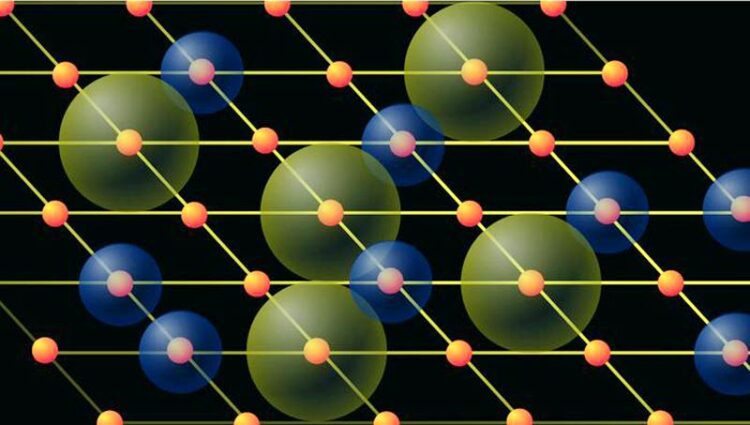A new design for quantum computers

Illustration of a quantum simulator with atoms trapped into a square lattice with lasers. The small spheres at the corners are atoms in their lowest energy state. The ones inside a blue sphere are exited (higher in energy) by the first laser, the ones inside yellow spheres are excited by the second laser (even more higher in energy).
Credit: TU Delft
Creating a quantum computer powerful enough to tackle problems we cannot solve with current computers remains a big challenge for quantum physicists. A well-functioning quantum simulator – a specific type of quantum computer – could lead to new discoveries about how the world works at the smallest scales. Quantum scientist Natalia Chepiga from Delft University of Technology has developed a guide on how to upgrade these machines so that they can simulate even more complex quantum systems. The study is now published in Physical Review Letters.
“Creating useful quantum computers and quantum simulators is one of the most important and debated topics in quantum science today, with the potential to revolutionise society”, says researcher Natalia Chepiga. Quantum simulators are a type of quantum computer, Chepiga explains: “Quantum simulators are meant to address open problems of quantum physics to further push our understanding of nature. Quantum computers will have wide applications in various areas of social life, for example in finances, encryption and data storage.”
Steering wheel
“A key ingredient of a useful quantum simulator is a possibility to control or manipulate it”, says Chepiga. “Imagine a car without a steering wheel. It can only go forward but cannot turn. Is it useful? Only if you need to go in one particular direction, otherwise the answer will be ‘no!’. If we want to create a quantum computer that will be able to discover new physics phenomena in the near-future, we need to build a ‘steering wheel’ to tune into what seems interesting. In my paper I propose a protocol that creates a fully controllable quantum simulator.”
Recipe
The protocol is a recipe – a set of ingredients that a quantum simulator should have to be tunable. In the conventional setup of a quantum simulator, rubidium (Rb) or cesium (Cs) atoms are targeted by a single laser. As a result, these particles will take up electrons, and thereby become more energetic; they become excited. “I show that if we were to use two lasers with different frequencies or colours, thereby exciting these atoms to different states, we could tune the quantum simulators to many different settings”, Chepiga explains.
The protocol offers an additional dimension of what can be simulated. “Imagine that you have only seen a cube as a sketch on a flat piece of paper, but now you get a real 3D cube that you can touch, rotate and explore in different ways”, Chepiga continues. “Theoretically we can add even more dimensions by bringing in more lasers.”
Simulating many particles
“The collective behaviour of a quantum system with many particles is extremely challenging to simulate”, Chepiga explains. “Beyond a few dozens of particles, modelling with our usual computer or a supercomputer has to rely on approximations.” When taking the interaction of more particles, temperature and motion into account, there are simply too many calculations to perform for the computer.
Quantum simulators are composed of quantum particles, which means that the components are entangled. “Entanglement is some sort of mutual information that quantum particles share between themselves. It is an intrinsic property of the simulator and therefore allows to overcome this computational bottleneck.”
Journal: Physical Review Letters
Method of Research: Computational simulation/modeling
Subject of Research: Not applicable
Article Title: Tunable quantum criticality in multicomponent Rydberg arrays
Article Publication Date: 15-Feb-2024
Media Contact
Pauline Bijster
Delft University of Technology
h.p.bijster@tudelft.nl
All latest news from the category: Physics and Astronomy
This area deals with the fundamental laws and building blocks of nature and how they interact, the properties and the behavior of matter, and research into space and time and their structures.
innovations-report provides in-depth reports and articles on subjects such as astrophysics, laser technologies, nuclear, quantum, particle and solid-state physics, nanotechnologies, planetary research and findings (Mars, Venus) and developments related to the Hubble Telescope.
Newest articles

Future AR/VR controllers could be the palm of your hand
Carnegie Mellon University’s EgoTouch creates simple interfaces for virtual and augmented reality. The new generation of augmented and virtual reality controllers may not just fit in the palm of your…

‘Game changer’ in lithium extraction
Rice researchers develop novel electrochemical reactor. A team of Rice University researchers led by Lisa Biswal and Haotian Wang has developed an innovative electrochemical reactor to extract lithium from natural…

The blue-green sustainable proteins of seaweed
… may soon be on your plate. The protein in sea lettuce, a type of seaweed, is a promising complement to both meat and other current alternative protein sources. Seaweed…



